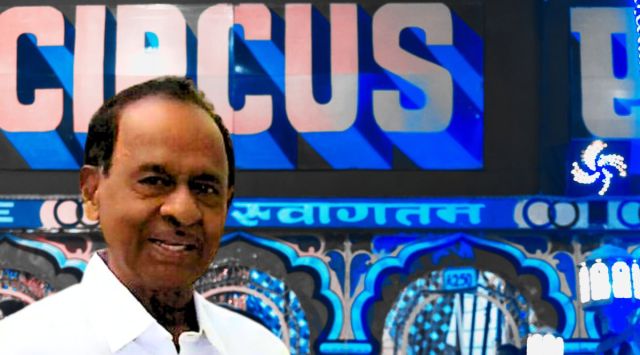Goodbye to the Ringmaster: Celebrating the life of Gemini Shankaran, grand old man of Indian circus
Shankaran, 99, founder of Gemini and Jumbo circuses, died in Kannur.
 Moorkoth Vengakandy Shankaran.
Moorkoth Vengakandy Shankaran. The trapeze artistes swung from one end of the giant tent to the other, gliding through the air and landing gracefully on dangling platforms. Moorkoth Vengakandy Shankaran, then a Class 4 student, sat transfixed as he looked up at the giant circus canopy, watching the acrobats in action at Kittunni, a local circus touring his village Kolassery near Thalassery in Kerala’s Kannur district.
This – the magical world of acrobats and performing artistes would be his world, Shankaran decided that day.
Early Monday, April 24, Shankaran, who straddled Indian circus as a colossus for seven decades as ‘Gemini Shankaran’, died in Kannur. He turned 99 in June last year.
Family sources said Shankaran had been admitted to a private hospital for the past few days due to age-related ailments. His cremation will be held in Kannur on Tuesday with state honours.
One of the pioneers of Indian circus, Shankaran became popular as Gemini Shankaran after the circus banner he established in 1951.
 Gemini Sankaran (Photo source: FaceBook)
Gemini Sankaran (Photo source: FaceBook)
A native of Thalassery, Kannur, the cradle of Indian circus, Shankaran’s life closely mirrors the history of circus in India, its ups and downs. Born in 1924, Shankaran got drawn to the circus at an early age.
In Class 7, Shankaran approached his father, a schoolteacher, with the idea of learning acrobatics. With the backing of his family, Shankaran, the fifth of seven siblings, dropped out of school and started martial arts and acrobatic training under the guidance of circus trainer-cum-performer Keeleri Kunhikannan, who belonged to the same region and had been credited with training scores of circus performers. Shankaran also ran a provision store for a short period.
Later, Shankaran joined the military and worked as a wireless operator during World War II. He quit the force after four years of service. Shankaran returned to his village in 1946 only to rekindle his passion for circus. He resumed his training under M K Raman, Kunhikannan’s disciple.
In 1948, Shankaran went to Calcutta (now Kolkata) and joined Baselion circus troupe — West Bengal was at that time the hub of famous circus troupes. Shankaran emerged as a star performer on the horizontal bar and trapeze and became a sought-after star in the industry. As a stellar trapeze performer, Shankaran moved from one tent to another.
 Born in 1924, Shankaran got drawn to the circus at an early age.
Born in 1924, Shankaran got drawn to the circus at an early age.
The turning point in his career, as well as Indian circus, came in 1951 when Shankaran and Sahadevan, also a circus performer, bought Vijaya Circus for Rs 6,000 and rebranded it ‘Gemini’, after Shankaran’s astrological sign. The Vijaya Circus had only a few performers, one elephant and two lions in its tent when it was reborn as Gemini. The first show of Gemini was at Bilimora in Gujarat on August 15, 1951. Shankaran was only 27 then.
That was a time when royal families kept animals such as elephants and lions in their personal zoos. With the decline of these royal families in the years after Independence, Gemini Circus bought many of their pets. Some even donated their animals to the circus.
In 1964, Gemini Circus became the first Indian troupe to attend the International Circus Festival in the USSR. They held shows in Moscow, Sochi and Yalta. Gemini Circus also became the backdrop of many Indian movies such as Raj Kapoor’s Mera Naam Joker.
With tents, a battery of performers and trained animals, Gemini toured from one continent to another, enthralling the audience and taking Indian circus to every part ofthe world.
 Political leaders, including Nehru, watched Gemini acrobats in action.
Political leaders, including Nehru, watched Gemini acrobats in action.
During its heyday, Gemini even had chartered flights to fly from one country to another. On occasions, they hired special trains for the movement of the troupe. Political luminaries and world leaders watched Gemini acrobats in action. Among them were Jawaharlal Nehru, the Mountbatten family, Martin Luther King, Indira Gandhi, Morarji Desai and V K Krishna Menon.
At the peak of the glory of circus as well as his career, Shankaran in 1977 established another circus — Jumbo — which also emerged as a game changer in the industry.
Tents of Gemini and Jumbo ballooned up simultaneously in different states. His troupes had a strong contingent of animals. At one time, Shankaran had 18 elephants, dozens of lions and scores of other animals, a few of them brought from abroad.
In 1997, after circuses placed restrictions on using animals, Shankaran arranged an asylum for his ‘star performers’ at a private estate in Wayanad before they were rehabilitated by the government.
In 1999, Shankaran stepped down as proprietor of Gemini. After a gap of five years, his sons Ajay Shankar and Ashok Shankar took over the reins of the circus.
But Shankaran did not keep away from his tents. Despite the flagging fortunes of the Indian circus industry, mainly after the ban on animal exhibition and the dwindling number of local performers, Shankaran remained an inspiration.
Raghu, a manager with Gemini, said Shankaran had been active in the industry until recently. “When the circus resumed last year after the Covid-19 pandemic, Shankaran inaugurated the show at Kunnamkulam in Thrissur. He had always been positive about the industry,’’ said Raghu.
Shankaran was honoured by the Union government with a lifetime achievement award as a recognition for his wide-ranging contribution to the circus in the country. He published a book about his circus adventures titled Malakkam Mariyunna Jeevitham.
A few years ago, when the Kerala government launched a circus academy at Thalassery, Shankaran came forward to bear the expenses of the academy and encouraged children from circus families to get enrolled there.
On Monday, when news of Shankaran’s death came, Gemini Circus was performing in Kanhangad in Kasaragod and Jumbo was in Bengaluru.







